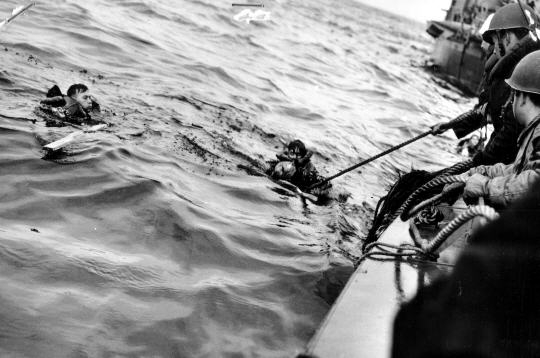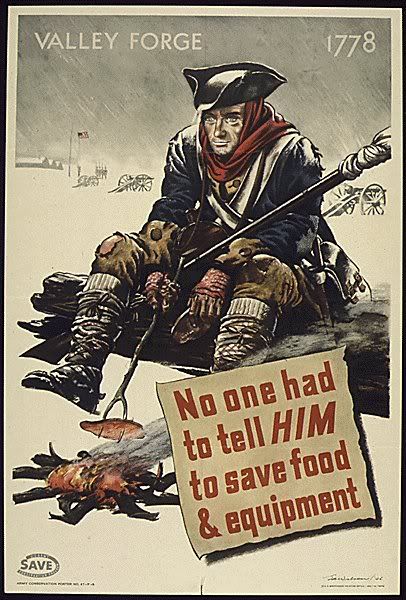Funny, it kind of looks like the barrel of that TD is pointed right at her head! What were they afraid of!? ![]()
|
For you what is the strongest image of the landing?
|
|
08-19-2009, 05:26 PM
08-19-2009, 05:32 PM
Ha!!! You are right, Capt O! I didn't notice that. Maybe the guys in the tank thought she was gonna beat on 'em with her cane & say: "You naughty boys are making too much noise with those big tanks!"
08-20-2009, 01:25 PM
08-21-2009, 05:20 AM
Soldiers from the 29th U.S. Infantry Division opened a café in Saint-Lô, to push the joke, They go as far as asking for a waitress ,"Waitress wanted"
Vee
08-21-2009, 12:05 PM
These are other photos that I can see any time I want to just by shutting my eyes and reverting to 1945. (I try hard but they won't go away),
Man's inhumanity to man.
Buchenwald Quarters with the stomach churning stench
Ebansee bodies are removed from barracks for a proper burial
Top/Sgt Leo
08-21-2009, 01:43 PM
The photos sure cross a gamut, don't they? I think we've have touched on almost every emotion from joy to abject sadness.
Marion J Chard
Proud Daughter of Walter (Monday) Poniedzialek 540th Engineer Combat Regiment, 2833rd Bn, H&S Co, 4th Platoon There's "No Bridge Too Far"
08-24-2009, 02:09 PM
More of my WW II Photos for your viewing if you so desire!! -------------------------------------------------------------
Troops examine the bodies strewn on the ground at Buchenwald.
Another Wagon Load of Ebensee Bodies to be properly buried
Looks pretty here but what happened inside was anything but!!! (Main Gate at Auschwitz,Poland Concentration Camp)
Three Plomium Chidren gingerly approach the massacre sight which they'll never forget.
This is an actual photo of one of the Reich Marschall's Shutz Staffel- Totenkopf Section
There is no truth that this is what I looked like at Valley Forge - not that old
Two of my Company in their Class "As"
Top/Sgt Leo
08-25-2009, 09:01 AM
Yes, I hardly think the folks who were there, need any photos as reminders, for I'm sure those awful images are permanently engraved in their brains. How sad to think how they must replay each and every day of their lives.
The same goes for all you veterans; how many times have you had to re-live moments you wished you could forget.
Great photos Sarge.
Marion J Chard
Proud Daughter of Walter (Monday) Poniedzialek 540th Engineer Combat Regiment, 2833rd Bn, H&S Co, 4th Platoon There's "No Bridge Too Far"
08-25-2009, 09:59 AM
HOW CAN WE FORGET, AFTER SEEING
WILLIE AND JOE walking after over 600 days of combat.
08-25-2009, 12:13 PM
My last Ebensee posting as I still get sick thinking about this subject!!
POWs on the Day of Liberation:-
Ebensee concentration camp was established by the SS, to build tunnels for armaments storage near the town of Ebensee, Austria in 1943. It was part of the Mauthausen network.
Due to the inhumane working and living conditions, Ebensee was one of the worst Nazi concentration camps for the death rates of its prisoners. The SS used several codenames Kalk (English: limestone), Kalksteinbergwerk (English: limestone mine), Solvay and Zement (English: cement) to conceal the true nature of the camp.
Formation The construction of the Ebensee subcamp began late in 1943, and the first 1,000 prisoners arrived on November 18, 1943, from the main camp of Mauthausen and its subcamps. The main purpose of Ebensee was to provide slave labor for the construction of enormous underground tunnels in which armament works were to be housed. These tunnels were planned for the evacuated Peenemünde V-2 rocket development, but, on July 6, 1944, Hitler ordered the complex converted to a tank-gear factory. (This is why Intel was so interestedin this Camp)
Approximately twenty thousand inmates were worked to their deaths to construct giant tunnels in the surrounding mountains. Together with the Mauthausen subcamp of Gusen, Ebensee is considered one of the most horrific Nazi concentration camps.
Jews formed about one-third of the inmates, a percentage increased to 40% at the end of the war, and were the worst treated, though all inmates suffered great harships. The other inmates included Russians, Poles, Czechoslovaks, and Gypsies, as well as German and Austrian political prisoners and criminals.
Conditions Prisoners arose at 4:30 A.M. and worked until 6:00 P.M., constructing and expanding tunnels. After some months, work was done in shifts, 24 hours a day. There was almost no accommodation to protect the first batch of prisoners from the cold Austrian winter, and deaths increased greatly. Bodies were piled in heaps and taken every three or four days to the Mauthausen crematorium to be burned; Ebensee did not yet have its own crematorium. The bodies of the dead were also piled inside the few huts that existed. The smell of the dead, combined with the stenches of sickness, phlegm, urine, and feces, was said to be unbearable.
Prisoners wore wooden clogs, or went barefoot when the clogs fell apart. Lice infested the camp. In the morning, food rations consisted of half a liter of ersatz coffee; at noon, of three quarters of a liter of hot water containing potato peelings; and, in the evening, of 150 grams of bread. Because of this treatment, the death toll continued to rise.
Liberation U.S. troops of the US 80th Infantry Division found the surviving prisoners at Ebensee crammed into disease-ridden, overcrowded barracks.As the Second World War in Europe came to an end, mass evacuations from other camps put tremendous pressure on the Mauthausen complex, the last remaining concentration camp in the area still controlled by the Nazis. The 25 Ebensee barracks had been designed to hold a hundred prisoners each, but they eventually held as many as 750 apiece. To this number, one must add the prisoners being kept in the tunnels or outdoors, under the open sky.
The crematorium was unable to keep pace with the deaths. Naked bodies were stacked outside the barrack blocks and the crematorium itself. In the closing weeks of the war, the death rate exceeded 350 a day. To reduce congestion, a ditch was dug outside the camp and bodies were flung into the quicklime. On a single day in April, 1945, a record eighty bodies were removed from block 23 alone; in this pile, feet were seen to be twitching. During this period, the inmate strength reached a high of eighteen thousands.
American troops of the US 80th Infantry Division arrived at the camp in May 6, 1945 - though for many inmates liberation came too late and they died of hunger, disease and exhausion despite the efforts of American doctors to save them.
Post-war commemoration In the immediate aftermath of liberation, former Polish inmates erected a stark concrete monument on the mass graves of their fellow prisoners who did not survive. In the first decades after the war, however, no other commemoration efforts were undertaken. To the contrary, the site of the concentration camp was designated for development as a residential area; many of the remaining camp structures except for its gate were demolished. Moreover, during the 1960s a former SS officer for some time became mayor of Ebensee, without his Nazi past arousing much attention.
However, a drastically changed attitude followed in the wake of the 1988 election of Kurt Waldheim as President of Austria and the revelations of his Nazi career. Ebensee, like many other locations in Austria, was touched by the controversy and the need to face Austria's past.
In Ebensee there was a determination to commemorate the events and preserve what camp remnants were still there. The tunnels, which had been dug by the slave labourers, remained intact but they were neglected and their existence largely unknown.
In 1997 Mayor Herwart Loidl presided over the placing of memorial plaques in the tunnels, commemorating the severe hardships of the slave workers who built them, and to those who had died there. Access to the underground chambers was created through the stairs known as "Lowengang" (English: Lions' Walk). The tunnels since opening have seen increasing number of visitors, from abroad as well as Austrian students who are learning about the past.
Today, a former school house has been turned into the Zeitgeschichte Museum und KZ-Gedenkstätte Ebensee, which holds regular lectures and readings, publishes a journal about the war period, and hosts an annual commemoration attended by surviving former inmates from different countries. It exhibits photographs, testimonies and relics from the camp.
Top/SgtLeo |
|
« Next Oldest | Next Newest »
|
| Possibly Related Threads… | |||||
| Thread | Author | Replies | Views | Last Post | |
| New mystery arises from iconic Iwo Jima image | sixgun | 1 | 4,761 |
11-26-2014, 04:46 PM Last Post: Walt's Daughter |
|
| Normandy Landing, DDAY hours per hours | sixgun | 0 | 3,276 |
11-06-2012, 03:39 PM Last Post: sixgun |
|
| Normandy D-Day Landing photos | Walt's Daughter | 15 | 21,227 |
12-10-2010, 01:31 PM Last Post: Walt's Daughter |
|
| Beach Landing Operations, 43-45 Photos | Walt's Daughter | 3 | 6,719 |
10-05-2006, 08:24 PM Last Post: mec1945 |
|
Users browsing this thread: 1 Guest(s)
















